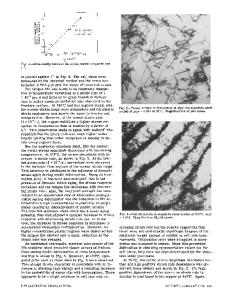Temperature and Strain Rate Dependence of Deformation-Induced Point Defect Cluster Formation in Metal Thin Foils
- PDF / 3,775,640 Bytes
- 6 Pages / 595 x 842 pts (A4) Page_size
- 90 Downloads / 351 Views
Temperature and Strain Rate Dependence of Deformation-Induced Point Defect Cluster Formation in Metal Thin Foils K. Yasunaga, Y. Matsukawa, M. Komatsu and M. Kiritani Academic Frontier Research Center for Ultra-high Speed Plastic Deformation Hiroshima Institute of Technology, Miyake 2-1-1, Saeki-ku, Hiroshima 731-5193, Japan ABSTRACT The mechanism of plastic deformation in thin metal foils without involving dislocations was examined by investigating the variations in vacancy cluster formation during deformation for a range of deformation speeds and temperatures. The deformation morphology was not seen to change appreciably over a very wide range of strain rate, 10-4/s – 106/s, whereas the number density of vacancy clusters was observed to increase with increasing strain rate up to saturation value that is dependent on materials and temperature. The density of vacancy clusters decreased to zero with decreasing deformation speed. The strain rate at which the density of vacancy clusters begins to decrease was found to be proportional to the vacancy mobility, suggesting that the vacancies are generated as dispersed vacancies and escape to the specimen surfaces during slow deformation without forming clusters. A very long tail in the distribution of the density of vacancy clusters towards lower strain rates was reasonably attributed to the generation of small vacancy complexes due to deformation. These results give valuable information that can be used to establish new models for plastic deformation of crystalline metals without involving dislocations. INTRODUCTION Through their previous research, the present authors have demonstrated that the plastic deformation of metal thin foils proceeds without crystal dislocations [1, 2]. As a consequence of heavy plastic deformation, which ends in fracture, vacancy clusters are produced at high density, in the form of stacking fault tetrahedra, even in aluminum. Understanding the mechanism of vacancy cluster formation is believed to lead to the development of a new deformation mechanism model that does not involve dislocations. The experiments in this study were conducted to pursue variations in vacancy cluster formation according to deformation speed and deformation temperature. These experiments clarified the previously unresolvable question of whether vacancy clusters are directly formed by deformation or whether they are formed by the aggregation of dispersed vacancies introduced by deformation. EXPERIMENTAL PROCEDURE Annealed metal films (Al, Au, Cu and Ni, all 99.99% purity) in ribbon form (20 m x 3 mm x 10 mm) were cut half way across in the middle of their length in order to initiate deformation at that point. The elongation speed of the films varied over a wide range: 10-9 – 1 m/s. High-speed deformation was performed by pulling the ribbon apart at a speed of 1 m/s, and slow deformation was performed using a deformation rig, the cross-head speed of which could be set as low as 1 mm/week by gearing-down the drive motor in many stages. The deformation presently of interest
Data Loading...











